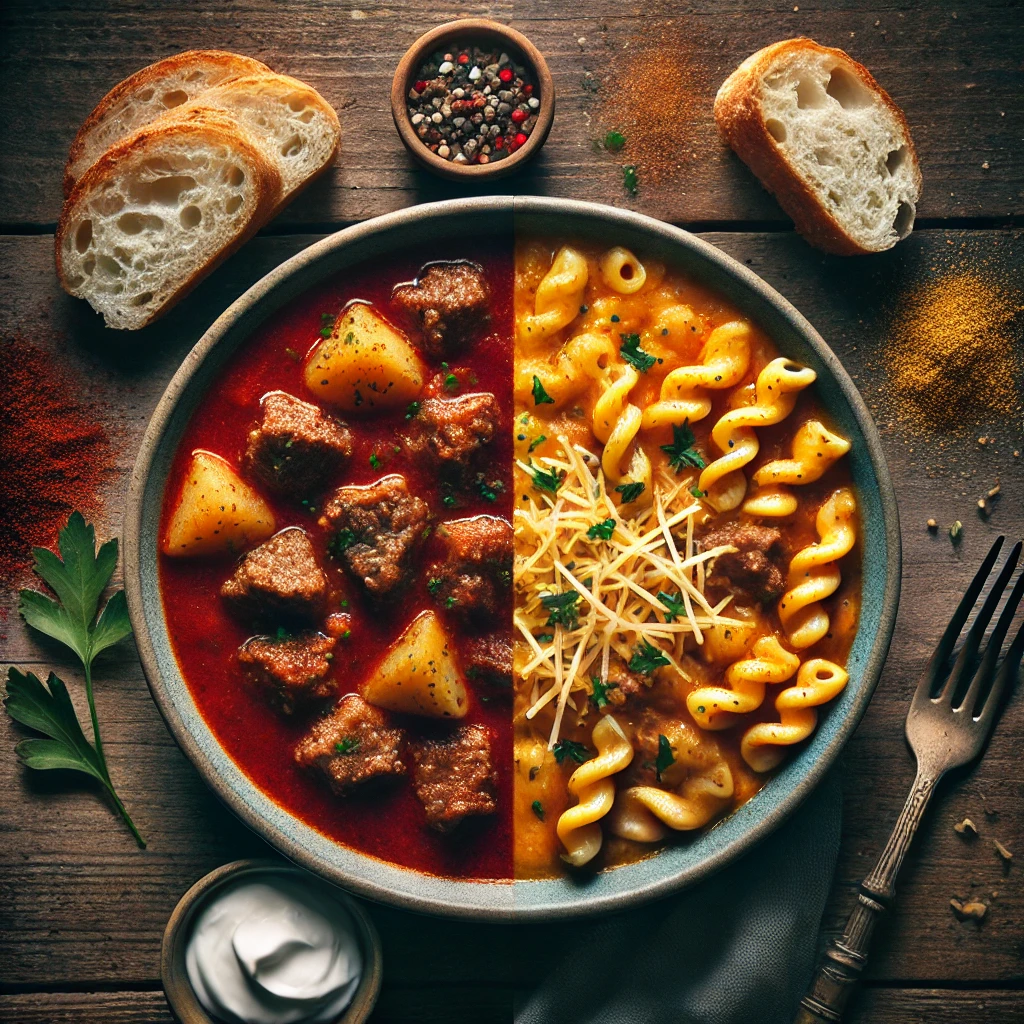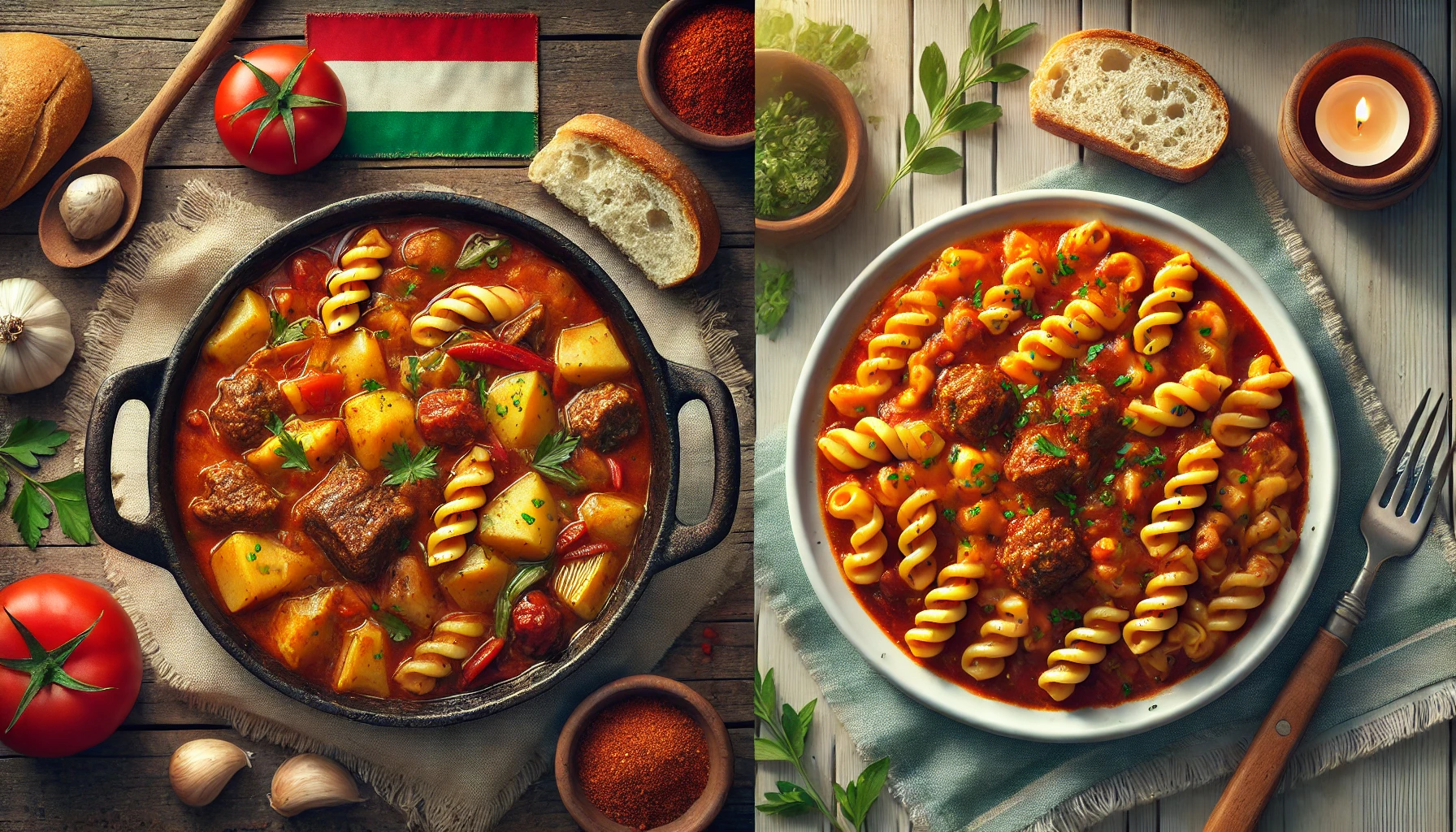Goulash is a beloved dish with roots in Europe, yet it has taken on a distinct identity in the United States. When we talk about Hungarian goulash and American goulash, we refer to two comfort foods that share a name but differ significantly in ingredients, preparation, and cultural significance.
Origins of Hungarian Goulash
Hungarian goulash, known as gulyás, is a centuries-old dish originating from the Magyar shepherds in the 9th century. It has evolved into Hungary’s national dish, revered for its rich flavor and hearty ingredients. Traditionally, Hungarian goulash make this dish with beef stew, using chunks of meat, onions, and a generous amount of Hungarian paprika. This paprika gives goulash its signature vibrant red color. Originally, they cooked Hungarian goulash in cast-iron kettles over an open fire, which imparted a smoky flavor synonymous with traditional Hungarian cuisine.
For a detailed exploration of a traditional Hungarian goulash recipe, check out Saveur’s guide.
Origins of American Goulash
On the other side of the Atlantic, this food emerged during the Great Depression, a time when families had to stretch limited ingredients to feed large families. This version diverges significantly from its Hungarian namesake. American goulash typically includes ground beef, macaroni, and a tomato-based sauce. It offers a one-pot meal that simplifies cooking, speeds up preparation, and keeps costs low.
For more insights into the variations of American goulash, you can explore Serious Eats’ take.

Key Differences in Ingredients
When comparing these two dishes, the first thing that stands out is the ingredients:
- Hungarian Goulash:
- Beef chunks
- Paprika (various types, from sweet to spicy)
- Onions, tomatoes, garlic
- Caraway seeds, potatoes
- Optional additions: sour cream, bell peppers
- American Goulash:
- Ground beef
- Macaroni pasta
- Canned tomatoes, tomato sauce
- Onions, green peppers, celery
- Seasonings: oregano, garlic powder, bay leaf
Many American versions often omit or use paprika, a cornerstone of Hungarian goulash, sparingly. Instead, the emphasis is on the combination of meat and pasta, making it a more straightforward, less spicy dish.
Cooking Process
The cooking methods further highlight the distinction between the two:
- Hungarian Goulash:
- Slow-cooked, often over several hours, to develop deep, rich flavors.
- Cooked in a large pot or kettle, with a focus on simmering the beef until tender.
- The dish is thickened naturally by the ingredients, with no need for additional thickeners.
- American Goulash:
- A quick, one-pot meal designed for convenience.
- Ground beef is browned first, followed by the addition of vegetables and tomato sauce.
- Macaroni is cooked directly in the sauce, allowing it to absorb the flavors.
The slow-cooked nature of Hungarian one results in a stew with a rich, hearty consistency, while American one is more of a meaty pasta dish, often referred to as “hamburger soup” or “slumgullion.”
Taste and Texture
The taste and texture of Hungarian and American one are as different as their ingredients and preparation methods:
- Hungarian Goulash:
- Rich, deep, and complex flavors, primarily due to the liberal use of paprika and the slow-cooking process.
- Thick and stew-like in consistency, with tender beef and a robust, smoky flavor.
- American Goulash:
- Milder in flavor, with the tomato sauce being the predominant taste.
- The texture is more pasta-like, with the macaroni absorbing much of the sauce, resulting in a comforting, less intense dish.
Cultural Significance and Evolution
Hungarian goulash is more than just a dish; it’s a symbol of national pride and culinary heritage. It has remained relatively unchanged over the centuries, staying true to its origins. On the other hand, American one reflects the ingenuity and resilience of American home cooks, who adapted a traditional dish to meet the needs of a different time and place.
This evolution is evident in the many regional variations of American one, where ingredients and preparation methods are tweaked to suit local tastes and available resources. Despite these changes, both versions of goulash continue to be beloved comfort foods in their respective cultures.
FAQs
What is traditional Hungarian goulash?
Traditional Hungarian goulash is a rich, hearty stew made with beef, paprika, onions, and other vegetables, slow-cooked to perfection.
Why do people call American goulash ‘goulash’? It takes its name from the Hungarian dish, but it has evolved into a different, simpler meal featuring ground beef, macaroni, and tomato sauce.
Can Hungarian goulash be made with other meats?
Yes, while beef is traditional, Hungarian goulash can be made with pork, lamb, or even chicken, depending on regional variations and personal preferences.
Is American goulash the same as American chop suey?
In some regions, people consider American goulash and American chop suey the same dish, though the ingredients and seasonings vary.
How can I make the American more like Hungarian goulash?
To make American more like Hungarian one, consider adding paprika, replacing ground beef with chunks of beef, and cooking the dish slowly to develop deeper flavors.
Conclusion
Understanding the differences between Hungarian and American goulash highlights the unique cultural identities they represent. While Hungarian goulash remains a traditional, slow-cooked stew full of rich flavors, American goulash offers a quicker, more accessible alternative that has become a staple of American comfort food. Whether you prefer the hearty stew of Hungary or the pasta-based dish of the United States, both versions provide a comforting meal that continues to warm hearts and homes.
For a deep dive into using paprika in cooking, you can visit The Spruce Eats.
